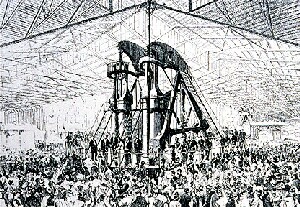|
1 2 |
 Copyright: Sandhurst 1876, S. 234 |
On the opening day, 10 May 1876, most of the buildings had been finished. The interior facilities, however, had yet to be completed in many cases. Russia’s and China’s exhibits only arrived six days later. To make matters worse, rain that had lasted for days had soaked the exhibition lawns. Nonetheless, more than 200,000 visitors took part in the ceremony. Some of the honorary guests, which included the whole of Congress – brought in from Washington in three extra trains – important civil servants, diplomats from all 37 participating countries and the only foreign head of state, the Emperor Pedro of Brazil, later complained about the lack of organisation. Thus it was hardly possible to hear the ceremonial march composed by Richard Wagner specifically for this occasion. And this in spite of the fact that – as the ‘Philadelphia Inquirer’ remarked – he was distinguished as the loudest of all composers. Wagner himself said that the best thing about the composition was the reward of $5,000.
After many a speech, poem, choir and 100 salutes, the honorary guests visited the exhibits in the Main Hall and the Engine Hall in a long procession. Following a lunch break, the opening ceremony’s most remembered moment took place: The American president Ulysses S. Grant and the Emperor of Brazil together switched on the largest ever steam engine of the day – a 600 tonnes monster built by Corliss. By driving belts and steam pipes, hundreds of machines and pumps were set in motion, water cascades tumbled into a large basin, and the whole Engine Hall shook with noise. The crowd broke our in cheers and everyone threw their hats into the air.
The Programme of the opening ceremony:
The National Commemoration, under the direction of the United States Centennial Commission. Independance Square, Philadelphia, July 4, 1876.
1. GRAND OUVERTURE, THE GREAT REPUBLIC, founded on the National Air, Hail Columbia, and arranged for the occasion by the composer, Georg F. Bristow, of New York. Orchestra - P.S. Gilmore, Musical Director for the day.
2. THE PRESIDENT OF THE COMMISSION, Joseph R. Hawley will call the assembly to order, and announce the President of the United States, or, in his absence, the Vice-President, Hon. Thomas W. Ferry, as the presiding officer of the day.
3. PRAYER, by the Rt. Rev. William B. Stevens, D.D., Bishop of Pennsylvania.
4. HYMN, WELCOME TO ALL NATIONS. Words by Oliver Wendell Holmes, of Massachusetts. Music, Keller's Hymn. Orchestra and Chorus.
5. READING OF THE DECLARATION OF THE INDEPENDENCE, by Richard Henry Lee, of Virginia. The original manuscript will be brought forward for the purpose by his Honor the Mayor of Philadelphia, to whose care it has been intrusted by the President of the United States.
6. GREETING FROM BRAZIL, a Hymn for the First Centennial of American Independence, composed by A. Carlos Gomes, of Brazil, at the request of His Majesty Dom Pedro II., Emperor of Brazil. Orchestra.
7. POEM, THE NATIONAL ODE, by Bayard Taylor, of Pennsylvania. Introduced by John Welsh, President of the Centennial Board of Finance.
8. GRAND TRIUMPHAL MARCH, WITH CHORUS, OUR NATIONAL BANNER. Words by Dexter Smith, of Massachusetts. Music by Sir Julius Benedict, of England. Orchestra and Chorus.
9. ORATION, by William M. Evarts, of New York.
10. HALLELUJAH CHORUS, from Handel's Messiah. Orchestra and Chorus.
11. DOXOLOGY, THE OLD HUNDREDTH PSALM, in which all present are requested to join.
Quelle: US Centennial Commission: International Exhibition 1876. Report of the Director-General. Vol. 1. Philadelphia 1879.
| Year: 1876 | City: Philadelphia | Country: USA |
| Duration: 10th May - 10th November 1876 | ||